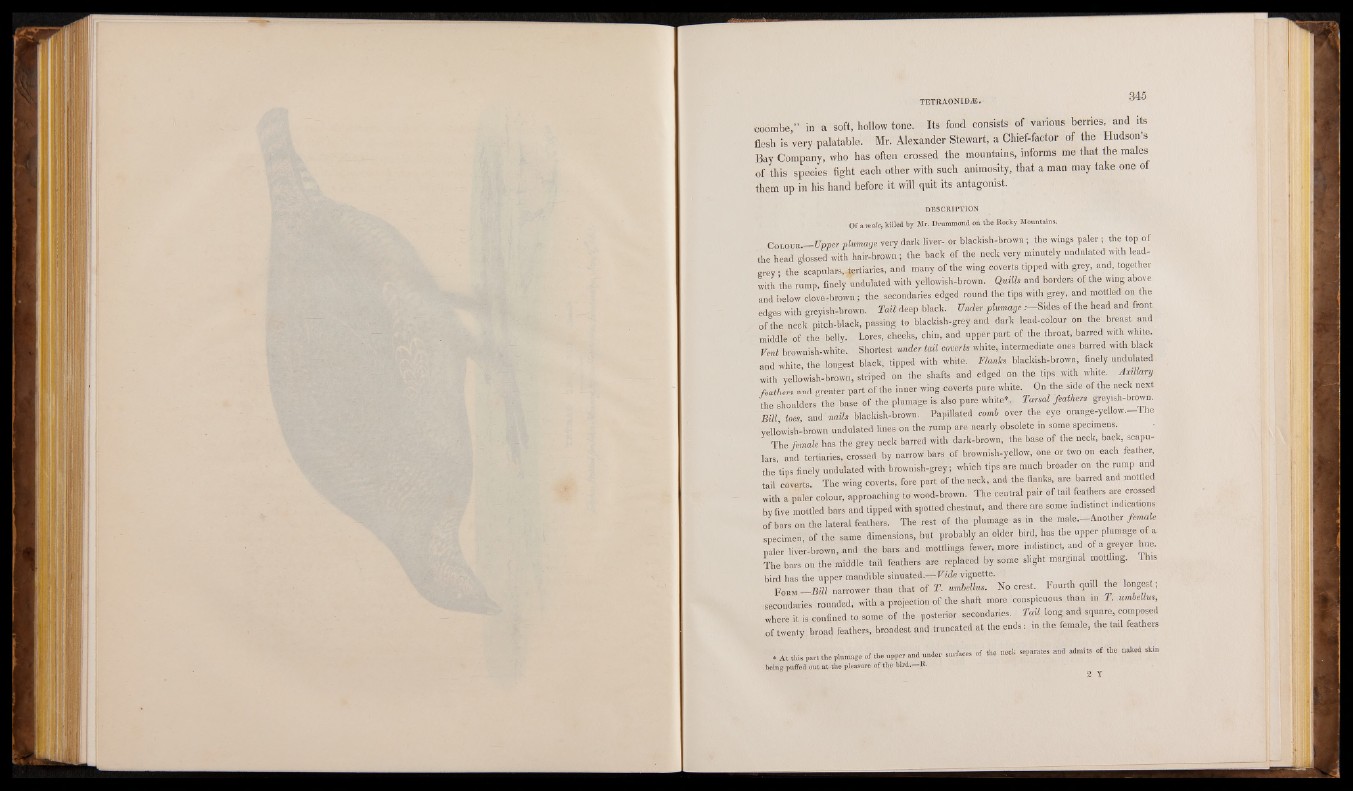
coombe/’ in a soft, hollow tone. Its food consists of various berries, and its
flesh is very palatable. Mr. Alexander Stewart, a Chief-factor of the Hudson’s
Bay Company, who has often crossed the mountains, informs me that the males
of this species fight each other with such animosity, that a man may take one of
them up in his hand before it will quit its antagonist.
DESCRIPTION
Of a male, killed by Mr. Drummond on the Rocky Mountains.
W — very dark liver-or blackish-brown ; the wings paler; the top of
the head glossed with hair-brown ; the back of the neck very minutely undulated with lead-
grey the scapulars,4ertiaries, and many of the wing coverts tipped with grey, and, together
with the rump, finely undulated with yellowish-brown. Quills and borders of the wing above
and below clovelbrown ; the secondaries edged round the tips with grey, and mottled on the
edges with greyish-brown. Tail'.deep black. Under plumage .-—Sides of the head and front
of the neck pitch-black, passing to blackish-grey and dark;,; lead-colour on the breast and
middle of the belly. Lores, cheeks, chin, and upper part of the throat, barred with white.
Vent brownish-white. Shortest under tail coverts white, intermediate ones barred with black
and white, the longest black, tipped with white. Flanks blackish-brown, finely undulated
with yellowish-brown, striped on the shafts and edged on the tips with white. Jnllary
feathers and greater part of the inner wing coverts pure white. On the side of the neck next
the shoulders the base Of the plumage is also pure white*. Tarsal 'feathers greyish-brown.
Bill toes, and nails blackish-brown. Papillated comb over the eye orange-yellow, lhe
yellowish-brown undulated lines on the rump are nearly obsolete in some specimens.
The female has the grey neck barred with dark-brown, the base of the neck, back, scapulars
and tertiaries, crossed by narrow bars of brownish-yellow, one or two on each feather,
the’tips finely undulated with brownish-grey; which tips are much broader on the rump and
tail coverts. The wing coverts, fore part of the neck, and the flanks, are barred and mottled
with a paler colour, approaching to wood-brown. The bentral pair of tail feathers are crossed
by five mottled bars and tipped with spotted chestnut, and there are some indistinct indications
of bars on the lateral feathers. The rest of the plumage as in the male.-^Another female
specimen, of the same dimensions, but probably an older bird, has the upper plumage of a
paler liver-brown, and the bars and mottlings fewer, more indistinct, and of a greyer hue.
The bars on the middle tail feathers are replaced by some slight marginal mottling. This
bird has the upper mandible sinuated.— Vide vignette. - .J f lH jH H B
Form- B ill narrower than that'of T. umhellus. No crest. Fourth quill the longest;
secondaries rounded, with a projection of the shaft more conspicuous than in T. umhellus,
where it is confined to some of the posterior. secondaries. Tad, long and square, composed
of twenty broad feathers, broadest and truncated at the ends: in the female, the tail feathers
* At this part the plumage of the upper and under snrfaees of the neck separates and admits of the naked skin
being -puffed out a . t -the pleasure of the bird.—R. 2 Y